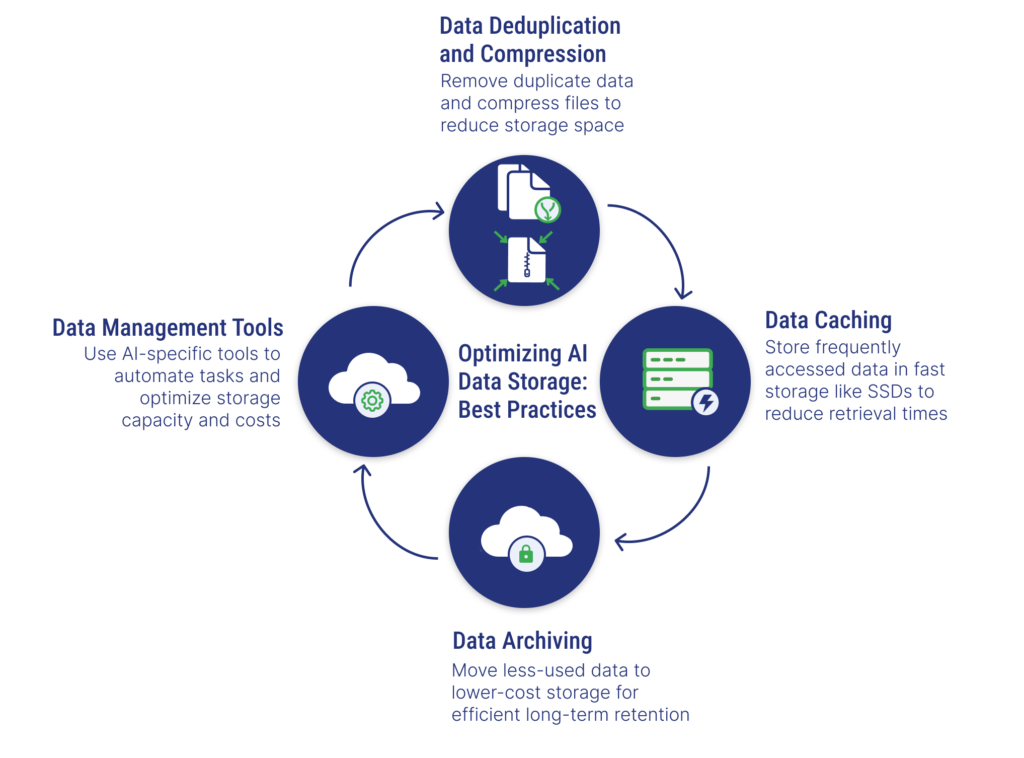
Data growth is increasing rapidly and is set to reach 180 zettabytes by 2025. A significant contributor to this growth is artificial intelligence (AI), a large category describing a branch of computer science that involves systems that can learn, reason, and act autonomously if instructed to do so. Managing the datasets associated with these AI models can become complex quickly. Businesses that are looking to harness the benefits of AI for their business services and processes can’t ignore the demands on AI data storage. We’ll explore key strategies and best practices for managing AI data storage effectively.

The Importance of Proper Data Storage for AI
Proper data storage is essential for any business looking to embrace the full benefits of AI. Large datasets are required to train AI models, and AI tools also produce a lot of data after processing and analysis. Organizations that can’t accommodate the amount of data that needs to be stored will experience performance issues and might even find that their AI technologies are not useful if the massive datasets aren’t managed effectively.
What Are the Challenges of Managing and Storing Massive AI Data?
There are some common challenges associated with managing and storing AI data, including the volume, complexity, and performance of that data.
Data Volume and Velocity
AI models require large datasets to achieve high accuracy and peak performance, leading to massive data volumes. Numerous applications also require real-time or near real-time data processing, compounding the challenge of efficiently managing both data scale and velocity. This dual demand for expansive data and rapid processing creates a complex landscape for AI implementation, where organizations must balance the need for comprehensive information with the need for swift, actionable insights.
Data Complexity and Variety
Depending on what you’re using AI data sets for, you may be working with AI models that use text, images, audio, as part of training and production. Most of the data generated can also be unstructured, making it hard to process and analyze. This complexity and variation can also lead to data quality issues, meaning large data sets feel even more unwieldy.
Scalability and Performance
As data generation and collection continue to grow exponentially over time, businesses have to think about scaling up much faster than if they weren’t using AI datasets. Keeping up with the demand isn’t just a capacity issue – organizations also need to understand how to keep performance high to ensure efficient access to data.
3 Types of AI Data Storage to Consider
If you are working with AI data and are looking for ways to store it, there are three main options: hybrid cloud-based storage, data lakes/warehouses/lakehouses, and object storage.
Hybrid Cloud-Based AI Data Storage
Hybrid cloud-based AI storage can work with your current environment, adding a cloud resource that scales storage capacity based on changing volumes on-demand. This removes the need to invest in additional hardware infrastructure. Data can also be accessed anywhere you have an internet connection, making it ideal for Software as a Service (SaaS) applications. TierPoint offers solutions like Storage as a Service (STaaS), which provides secure, cost-effective, and scalable storage solutions that can support AI data in the cloud.
Data Lakes, Data Warehouses, or Data Lakehouses
While similar, data lakes, data warehouses, and data lakehouses are all distinct approaches with their own pros and cons.
A data lake is a central repository that stores all types of raw data, regardless of how structured it is or what type it is. This repository type is very flexible and scalable and can be good for businesses exploring their data sets without specific reports in mind. This might be for capturing data from IoT devices, social media data, or customer logs that aren’t tied to a specific set of structured data.
Data warehouses as opposed to a data lake, store structured data and are used for specific analysis purposes. If you’ve got something consistent, such as purchase history, you can use a data warehouse to analyze sales trends. However, it’s not as flexible and can be hard to use if you are working with unstructured data.
A data lakehouse combines data lake flexibility with data warehouse structure. If you are looking to do some exploratory analyses and specific reporting, a lakehouse can serve as the best of both worlds, but it can be difficult to set up.
Object Storage
Object storage is meant for storing and managing large amounts of unstructured data. This type of storage is highly scalable and good for large media files, archives, and backups. This isn’t a form of storage that’s meant for analysis, like data lakes/warehouses/lakehouses. Instead, this is meant more for backups. An example use case might be media companies looking for ways to store their image and video files for later use in a story.
How Can You Optimize Data Storage for AI?
By implementing the following best practices, businesses can optimize data storage for AI while reducing storage costs, enhancing the effectiveness of AI initiatives, and improving performance for internal and external users.

Data Deduplication and Compression
Duplicated data can create an unnecessary load on resources. Deduplication can find and eliminate duplicate data to decrease storage requirements. Compression algorithms can keep quality high while reducing the size of data files. Organizations may also want to consider AI-specific data formats that are optimized for storage and processing.
Data Caching
When you cache frequently used data, you can improve access times to the data by storing it in a faster storage layer, such as a high-performance solid-state drive (SSD) or memory storage. This reduces the time necessary to retrieve data.
Caching strategies can include read-ahead (pre-fetching data that is likely to be needed in the future), write-behind (delaying writing data to the main storage data to batch and boost write performance), and eviction policies that determine how often cached data should be removed.
Data Archiving
Not all data needs to be accessed quickly or often. Data archiving can move less frequently accessed data to lower-cost storage tiers. Data retention policies can outline how long certain types of data should be archived for more manageable storage costs that remain compliant with any retention requirements.
Data Management Tools
Data management tools that are designed for AI workloads can automate certain tasks, optimize storage, and improve performance to increase capacity and decrease costs associated with AI data storage. Cloud-based solutions can be a more scalable, manageable way to handle AI data storage as well.
Other Considerations
Other things businesses might want to consider include data partitioning, data versioning, and quality assessment measures. Data partitioning divides datasets into smaller partitions to make processing and management easier. Data versioning will allow organizations to track data changes over time in case there’s a need to reproduce something or analyze changes more closely. Data quality assessment helps avoid errors in AI data training by checking for data accuracy and consistency along the way.
Transform Your AI Data Storage
If you’re using AI in your business processes, it’s time to change the way you think about storage. TierPoint understands the critical role data plays in AI, and we offer comprehensive services, such as Storage as a Service (STaaS), so businesses can keep up with exponential increases in demand. Our STaaS solutions can scale to meet your data volumes, optimize performance for better results, and reduce costs and complexity associated with storage footprints. Focus on core AI development and take storage management off your to-do list.

